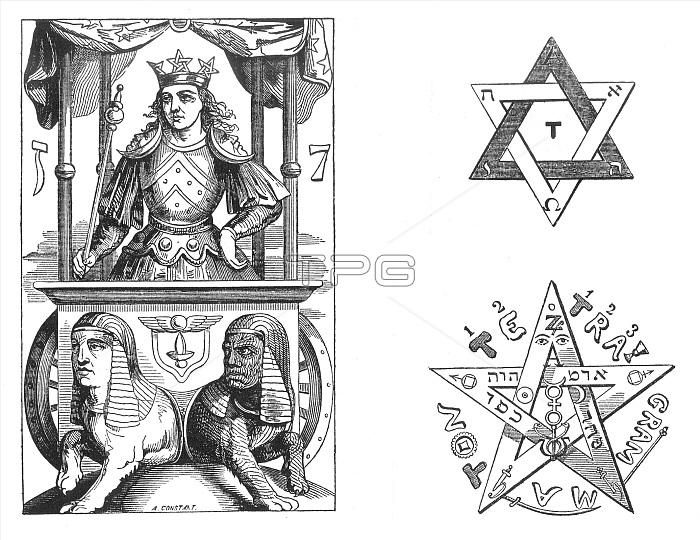
MAGIC SYMBOLS - CHARIOT TAROT - PENTACLES Eliphas Levi (the pseudonym of Louis Constant) was a journalistic occultist who misunderstood many esoteric teachings and traditions, and published his highly personal versions of these in a number of occult-seeming texts, where he succeeded mainly in issuing misleading information. In spite of his general inaccuracy about occult things, his writings have had a powerful influence on popular occult thought, since the late 19th century - especially so on Tarot design. His collections of 'esoteric symbols' [which are highly personal, and eclectic] are of value mainly because of their influence, rather than because of their intrinsic qualities. The symbols used here are from the 1896 English version of Levi's Transcendental Magic. Its Doctrine and Ritual. [Left] The Chariot of the Tarot deck, as proposed by Levi. Although Levi left a detailed description of each of the 22 picture cards of the Tarot, this seems to have been the only pictorial version of a card that he published. The card caught the attention of several late-19th century occultists, and influenced the design of a new Tarot deck, issued by Oswald Wirth (examples are available in the Charles Walker Collection). Many of the elements in the Levi Tarot found their way into the so-called Rider-Waite deck, by way of Oswald Wirth: notably, the replacement of the two horses by sphinxes, the Egyptian elements in the design, and the three pentacles in the headdress of the charioteer. [Top right] The Seal of Solomon. The Seal, which is a fairly standard image of the interlaced dark and light triangles, has been rendered meaningless by the addition of the central Tau, the Greek alpha and omega, and the Hebrew tetragrammaton (4-lettered name of God).
| px | px | dpi | = | cm | x | cm | = | MB |
Details
Creative#:
TOP17491487
Source:
達志影像
Authorization Type:
RM
Release Information:
須由TPG 完整授權
Model Release:
No
Property Release:
No
Right to Privacy:
No
Same folder images:

 Loading
Loading